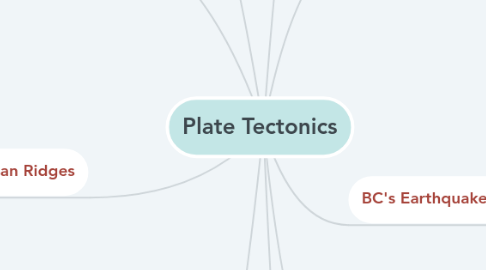
1. Layers of Earth
1.1. Crust
1.2. Mantle
1.3. Inner core
1.4. Outer core
2. Faults
2.1. What is a fault
2.1.1. A fault is in the earths surface where movement has occurred, and can be meters to kilometers long
2.2. Types of Fault
2.2.1. Normal Fault
2.2.1.1. When rock is stretched apart or in tension, one side of the fault slips down relative to the other. (Footwall on top while Hanging Fall slips down)
2.2.2. Reverse Fault
2.2.2.1. When rock is compressed together one side rises up. (Footwall is below the Hanging wall)
2.2.3. Transform Fault
2.2.3.1. When two plates slide past each other in different directions, which creates shallow earthquakes
2.2.4. Horst and Graben Fault
2.2.4.1. Steep sided valley formed when faulting causes a blocked shaped to drop
2.2.4.1.1. Horst: Land that moves upwards
2.2.4.1.2. Graben: Land that moves downwards
3. Mid- Ocean Ridges
3.1. 15 km above the ocean floor and 1500-2500 km wide
3.2. Sea-floor spreading
3.2.1. Is a process that occurs at Mid-Ocean Ridges, where new oceanic crust is formed through volcanic activity and then gradually moves away from the ridge
4. Plate Boundaries
4.1. Divergent
4.1.1. Two plate moving apart
4.1.2. Mid- Atlantic ridge
4.1.3. Causes
4.1.3.1. Earthquakes
4.1.3.2. Volcanos
4.1.3.3. Rift valley is formed
4.2. Transform
4.2.1. Where plates are slipping and sliding past each other
4.2.2. Causes
4.2.2.1. Volcanos
4.2.2.2. Earthquakes
4.3. Convergent
4.3.1. Two plates are colliding together
4.3.2. Causes
4.3.2.1. Fold mountains
4.3.2.2. Earthquakes
4.4. Subducting
4.4.1. When two plates move towards each other and meet, the heavier oceanic crust sinks below the continental forming a trench
4.4.2. Causes
4.4.2.1. Earthquakes
4.4.2.2. Volcanos
4.4.2.3. Trench
4.4.2.4. Island Arc
4.4.2.4.1. An island arc is a chain of volcanoes which alignment is arc-shaped, and are parallel and close to a boundary between two converging tectonic plates
5. Earthquakes
5.1. causes
5.1.1. volcano
5.1.2. landslides
5.1.3. mining blasting
5.1.4. nuclear testing
5.2. likely to occur at plate boundaries
5.3. measuring quakes
5.3.1. moment magnitude scale
5.3.1.1. measures the amount of energy released in a earthquake
5.3.2. mercalli scale
5.3.2.1. used for measuring an earthquakes intensity, on scale of 1-12
5.4. epicenter
5.4.1. the point on the Earth's surface directly above the focus, the point where the earthquake originates
6. Earthquake waves
6.1. Primary (P) Wave
6.1.1. seismic body wave that shakes the ground back and forth in the same direction and the opposite direction as the direction the wave is moving
6.1.2. can travel through solid and liquid
6.2. Secondary (S) Wave
6.2.1. seismic body wave that shakes the ground back and forth perpendicular to the direction the wave is moving.
6.3. Surface Love (L) Wave
6.3.1. most destructive wave because its surface moves like waves
6.3.2. most destructive wave because its surface moves like waves
7. BC's Earthquake Hazard
7.1. Off the coast of Vancouver is a convergence of two tectonic plates, which involve the Juan De Fuca plate and the Pacific plate. These 2 plates are subducting and have become stuck. Once they become unstuck the result will be a massive eathquake
8. Convection Current
8.1. Continents move because of convection currents in the earth's mantle
8.2. Found in the asthenosphere
8.3. Upwelling causes plate to move apart
8.3.1. Divergent plate boundary
8.4. Sinking causes plate to pull together
8.4.1. Convergent plate boundary
9. Plate Movement
9.1. plate movement causes
9.1.1. Folding
9.1.1.1. Process that bends and twist rocks due to compression or squezzing
9.1.2. Faulting
9.1.2.1. Process where rocks move past each other along a fracture or crack, occurs where plates are separating, sliding past, or coming together
9.1.3. Vulcanism
9.1.3.1. The movement of molten rocks or magma, beneath or above the earths surface
